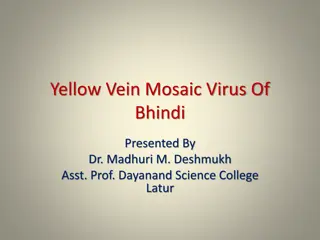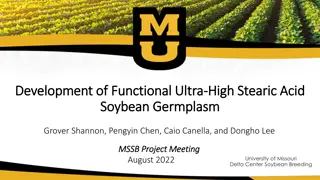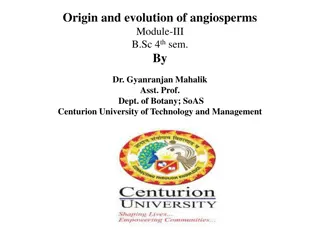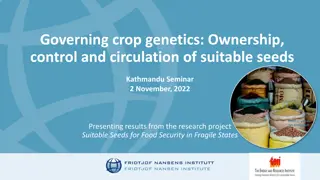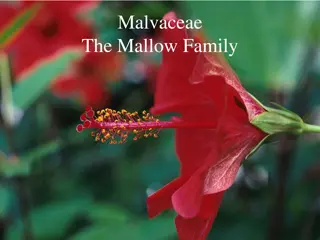Exploring the Diversity of Okra: Origin, Distribution, and Germplasm Collection
Abelmoschus esculentus, commonly known as okra, has a rich history and diverse characteristics. Originating from tropical Africa, it is widely cultivated in regions like India, Sri Lanka, and Bangladesh. This crop, with its varied chromosomal numbers in different species, holds significance in tropical and subtropical regions globally. The International Board for Plant Genetic Resources (IBPGR) and the National Bureau of Plant Genetic Resources (NBPGR) in India are pivotal in collecting and preserving okra germplasm. Learn about the ancestry, distribution, and conservation efforts surrounding this versatile plant.
Download Presentation

Please find below an Image/Link to download the presentation.
The content on the website is provided AS IS for your information and personal use only. It may not be sold, licensed, or shared on other websites without obtaining consent from the author. Download presentation by click this link. If you encounter any issues during the download, it is possible that the publisher has removed the file from their server.
E N D
Presentation Transcript
OKRA BREEDING G.Harika
INTRODUCTION S.N:- Abelmoschus esculentus C.N:- 2n=59 to 72 and 130 ORIGIN:- Abyssinian region (EHTIOPIA) In India it is widely distributed in states of karnataka, A.P, T.N, gujarath, punjab, haryana, maharashtra, W.B, etc.,
INTRODUCTION It is a crop of tropical and sub tropical lowland regions of Africa,Asia,America and warmer temperate region of the Mediterranean. A.tuberculatus-one of the ancestors of okra occurring in India has nine wild taxa of which A.esculentus is popularly grown for pod production. A.tetraphylus-18 old land races have been developed in this species in India.
ORIGIN AND DISTRIBUTION Its origin Is tropical Africa. The main region of cultivation and diversity of okra is in India, Srilanka, Pakistan, Nepal, Bangladesh. Two wild species A.crinitus and A.angulosus are exclusive origin of Asia. A.moschatus is present as wild form in Kerala, Maharashtra, Tamil nadu, Karnataka and Uttar pradesh.
CHARACTERISTICS OF Abelmoschus SPECIES SPECIES CHROMOSOME NUMBER WILD(W)/ CULTIVATED(C) A. angulosus 56 W A. tuberculatus 58 W A.moschatus 72 WC A.ficulneus 72 W A.tetraphyllus 138 W A.Tetraphyllus var.pungent 138 W A.crinitus 9 W A.callei 196 W A.manihot 66 WC A.esculentus 130 C
DISTRIBUTION Abelmoschus Species Distribution A.angulosus India and srilanka A.tuberculatus India A.moschatus India, nepal and srilanka A.ficulneus India and bangladesh A.tetraphyllus India, nepal and sirlanka A.tetraphyllus var.pungent India, nepal and srilanka A.crinitus India and srilanka A.callei India A.manihot India A.esculentus Worldwide
GERMPLASM COLLECTION IBPGR has degenerated NBPGR with global responsibility of base collection of Okra. Okra Germplasm collection programme is being carried out mainly through NBPGR New Delhi and Akola in Maharashtra. More than 8 specific explorations have already been organized, explosing and collections from Punjab, Haryana, Rajasthan, Gujarat, Central and western parts of Madhya Pradesh and Maharashtra, South Peninsular tract in Karnataka, Tamil Nadu and Kerala, Eastwards Andhra Pradesh, Orissa, Assam plains and adjoining hilly tracts of North Eastern region
The SAU and ICAR institutes have also made contribution to NBPGR, which holds more than 2,386 accessions of Okra, represented by 9 spp with maximum variability in A.esculentus.
GERMPLASM COLLECTION PUNJAB HARYANA RAJASTHAN GUJARAT MAHARASHTRA KARNATAKA TAMILNADU KERALA ANDHRA PRADESH ORISSA ASSAM
BREEDING PROGRAMMES IN INDIA Besides NBPGR, major centers includes IIVR (Varanasi), IIHR (Bangalore), PAU (Ludhiana), GAU (Junagarh), KAU (Trissur), OUAT (Bhubaneshwar).
Identified PROMISING LINES of okra for various attributes CHARACTER LINES Early flowering IC-128062, 11479, 117218, EC-325356, 329370 Long duration flowering IC-264697, 2647, EC-305749, 306741 Resistant to damping off, rhizoctonia solani Red ghana, sel7-1, BH-27, IC-12096 Resistant to PM Nigeria, EC-32598, IC8248, A. tetraphyllus, A.angulosus Resistant to cercospora blight Sel-7-1, round sel, EC-32598, A.crinitus, A.moschatus, A.angulosus Resistant to fusarium wilt IS-9273, pusa sawani, pusa makhmali
Resistant to YVMV A.manihot, parbhani kranti, punjab padmini, IC-1542, ACC-49, NIC- 9303A Resistant to jassids IC-7194, Sesswal local, IIHR 21, Crimson smooth Resistant to fruit borer A.tuberculatus, Red-1, pusa sawani, long green Resistant to nematode Long green smooth Tolerant to mite A. angulosus Resistant to leaf curl virus A. manihot
BREEDING OBJECTIVES There is a strong need to build-up adaptability To develop high-yielding hybrids capable of giving more marketable yield of dark green, tender, thin, medium-long, smooth and optimum seed setting ability. Pods should be free from conspicuous hairs
To breed early-maturing hybrids with a prolonged harvesting period. To evolve hybrids resistant to Yellow Vein Mosaic Virus(YVMV), Fusariumwilt, Cercospora leaf spot, Powdery mildew, etc., To combine resistance to Yellow vein mosaic virus with resistance to fruit and shoot borer,
To develop most suitable ideotype, short plants and more number of nodes with short internodes length. It would be more productive than tall plant with long internodal length. To evolve hybrids tolerant to abiotic stresses. To develop hybrids suitable for processing
BOTANY AND FLORAL BIOLOGY Plant:Erect, herbaceous annual, 1-2 m tall. Leaves: Alternate, 3-7 lobed, hirsute and serrate. Flower: Solitary, axillary with long peduncle. Epicalyx : Long, narrow hairy bracteoles.
Calyx: Splits longitudinally as the flower open. Petals: 5 cm, yellow with crimson spot on claw. Stamens: Staminal column is united to base of petals with numerous stamens.
Ovary: Superior. Fruit : Capsule. Stigma receptivity: on the day of flower opening.
Pollen viability: 55 days (in storage at 50% RH). After pollination it takes 2-6 hrs for fertilization. Protogyny: is reported in few varities. But out cross through insect can be 19% i.e, often cross pollinated.
Quantitative characters CHARACTER MODE OF GENE ACTION Plant height Monogenic Earliness Dominant Yield Additive gene action Fruits/plant Additive gene action Leaf margin Monogenic Pod colour Monogenic Pod shape Oleigogenic Pod spininess Monogenic Stem colour Monogenic Fruit harininess Monogenic
BREEDING METHODS INTRODUCTION A cultivar from Africa(Ghana) known as Abelmoschus manihot ssp manihot introduced into India. It has been sucessfully used as a source of resistance to YVMV in breeding of parbhani kranti and punjab padmini.
PURELINE SELECTION This is applicable to landraces/cultivars collected from FARMERS FIELD. For example, PUSA MAKHMALI was bred from a material collected from west bengal. Similarly, Co 1 is a single plant selection from RED WONDER.
PEDIGREE METHOD This method is applicable to the segregating generation after hybridization between desirable promising donors. The individual plant selection starts from F2 generation and continues till F5 or F6 generation. PUSA SAWANI was developed through this method in an intervarietal hybridization.
MUTATION BREEDING This method was attempted to evolve early yielding varieties and resistant to YVMV. Dalia cherian (1986) reported that gamma radiation(16-25Kr) affected qualitative and quantitative characters of interspecific hybrids and thus create wide variability. EMS-8(PUNJAB 8):- Pusa sawani treated with 1% EMS.
INTERSPECIFIC HYBRIDIZATION Incompatibility overcome by mixed pollen, repeated pollination, stigma extract of male parent. A.esculentus A.manihot var.ghana:- symptomless carrier of YVMV i.e., PUNJAB PADMINI PARBHANI KRANTI:- A.esculentus cv.pusa sawani A.manihot.
HETEROSIS BREEDING Heterosis has been successfully exploited in okra by using the phenomenon of MALE STERILITY and PROTOGYNY.
DISEASE RESISTANCE BREEDING YVMV(GEMINI VIRUS) Most devasting disease of okra. First reported by C.S.Kulkarni in 1942. Homogeneous interwoven network of yellow veins enclosing islands of green tissues is characteristic symptom. Transmission is by WHITE FLY(Bemisiatabaci)
Crosses of cultivated okra with Abelmoschus manihot under BC2/BC3 generation followed by pedigree method of breeding are expected to give YVMV resistant segregants. A. manihot accessions have shown resistance to YVMV. A. anamika, A. abhay, Prabhani kranti were intially highly tolerant. P.sawani:- The first example of successful breeding for disease and pest resistance at IARI, new delhi.
ENATION LEAF CURL First observed at IIHR in 1986 by S.J. Singh and O.P. Dutta. Initial symptoms were small, pin headed enations on leaves, followed by warty and rough texture of leaves. Bold enations are prominent on the under surface of leaves.
Virus transmission is by GRAFTING. Natural transmission is by WHITEFLY. No resistance source is reported.
METHODS OF HYBRID SEED PRODUCTION Hand emasculation and pollination: Female line buds (a day prior to anthesis) Slight ring cut at the base Remove the anthers with care Bag them In male line tie the bud a day prior to anthesis.
POLLINATION Pollen from freshly opened bud which are previously bagged from the male parent line is collected in the morning. Pollen is dusted directly on stigma of the emasculated flower of the female parent with the help of camel hair brush. For selfing, cover the individual flower with
VARIETIES HARBHAJAN Pusa sawani:- IC-1542 P.makhmali Pusa makhmali:- Early variety. Punjab padmini:- Resistant to cotton boll worm, jassids, YVMV. Co 1 MDU 1 Gujarath bhindi 1 A abhay:- Sister line of A.anamika.
Varsha uphar Kashi pragathi Kashi mohini Hisar unnath Pusa A 4 EMS 8 PARBHANI KRANTI:- Revolutionized variety.
SUBMITTED TO:- Dr.T.S.K. KIRAN PATRO mam Asst. Proffesor SUBMITTED BY SUSHMITHA.M. VHM/16-26


